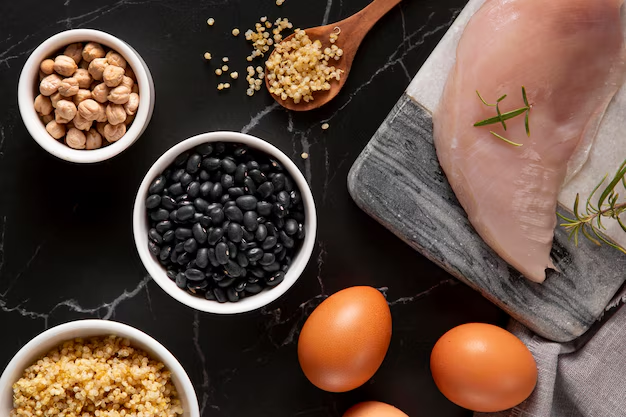Proteins are key in our bodies, doing a variety of important tasks. They are essential for cell work, and they help build our tissues and organs. Made of smaller parts called amino acids, there are 20 types that form proteins.
The order these amino acids are in decides a protein’s job and shape. This order comes from our genes, which are coded by DNA. So, proteins are really defined by our genetic instructions.
Key Takeaways
- Proteins are large, complex biomolecules that perform essential functions in the body.
- Proteins are made up of amino acids, with 20 different types that can be combined in various sequences.
- The sequence of amino acids determines the unique 3D structure and function of each protein.
- Proteins are involved in catalyzing chemical reactions, providing structural support, transporting molecules, and coordinating biological processes.
- Proteins are coded for by sequences of genes, which dictate their amino acid composition and folding.
Introduction to Proteins
Proteins are big molecules found in living things. They are made of long chains of amino acid parts. These biomolecules are crucial for many tasks in our bodies. They help with chemical reactions, copy DNA, sense things, give cells shape, and move stuff around.
Diverse Functions of Proteins
Each protein is different because of its amino acid sequence. This is based on the gene sequence. The sequence guides how the protein will fold into a 3D shape. This shape then decides what the protein will do. They can be enzyme helpers, motor proteins or membrane proteins. All these roles are vital for life.
Composition of Proteins
Proteins are built from amino acids. There are 20 kinds of these. They are put together differently to make the many proteins we see. Each protein can have hundreds to thousands of these parts. The way they are arranged makes up the protein’s shape and job.
Proteins are key for cells and creatures to live. They are essential for our life functions. Knowing about proteins helps us understand how life works today. This is a core part of biochemistry and molecular biology.
Structural Roles of Proteins
Proteins do vital work in our bodies, helping with structure and support. They play a key part in how our cells and tissues form. Structural proteins keep cells in the right shape and help them move.
Cell Structure and Support
The cytoskeleton is made of structural proteins like actin and myosin. It shapes cells and aids in their movement. Cell structure and support proteins also hold on to membrane proteins. These work as gateways, sensors, and connectors to the outside world.
Muscle Proteins
Actin and myosin are muscle proteins that we need for moving. They let our skeletal, cardiac, and smooth muscles contract. These structural proteins team up to produce muscle strength and movement.
Skin and Hair Proteins
Collagen and keratin do a lot for our skin, nails, and hair. Collagen is super abundant and keeps our skin strong and flexible. On the other hand, keratin is the main stuff in our hair and nails that shields them from harm.
Enzymes: The Catalytic Proteins
Enzymes act as catalysts in our bodies, speeding up chemical reactions. With their unique shape, they can grab onto specific molecules. By doing this, they make it easier for reactions to happen, which saves a lot of energy.
Enzyme Structure and Function
The design of enzymes is crucial for them to work. They have spots that catch certain molecules, known as substrates. When these molecules fit, the enzyme changes shape. This shape change makes it simpler for the reaction to take place.
Metabolic Enzymes
Metabolic enzymes are essential for the body’s life-sustaining reactions. For instance, phenylalanine hydroxylase helps change phenylalanine into tyrosine. This change is key in human metabolism.
Digestive Enzymes
Digestive enzymes break down big food molecules into smaller parts we can absorb. Urease, for example, aids in breaking down urea. There are also enzymes for carbs, fats, and proteins. They all help in the effective digestion of food.
Proteins in Transport and Storage
Proteins are key in moving and keeping substances in the body. Transport proteins move materials like oxygen and nutrients. They make sure these things get where they’re needed.
A well-known transport protein is hemoglobin. It carries oxygen from the lungs to body tissues. Ferritins, another type, help store and move iron. Iron is vital for red blood cell production and energy use.
Proteins also store important stuff for later. This keeps the body ready to use it when necessary. The work of transport and storage proteins is vital for cell and tissue health.
Proteins as Hormones and Messengers

Proteins act as hormones and messengers, helping cells, tissues, and organs communicate. These messenger proteins carry signals that control many biological functions.
Hormone Proteins
Hormones are special signaling proteins made by endocrine glands. They move in the blood, finding specific receptor proteins on cells to signal changes. For instance, growth hormone and insulin help in cell communication and regulation.
Signal Transduction Proteins
Besides, some proteins work as signal transduction messengers. They pick up extracellular signals to kickstart a series of inside-the-cell signaling events. This eventually changes how genes work or the jobs of cell proteins. This cell signaling system is key to keeping biological functions running smoothly within cells.
Immune Proteins
Proteins are key in our immune system. They guard us from pathogens and get rid of foreign substances. A wide range of immune proteins work together. They protect our body against infection.
Antibodies
Antibodies, or immunoglobulins, are vital Y-shaped proteins. B cells make them. They can spot and attach to certain antigens on pathogens or sick cells. Immunoglobulin G (IgG) is very important. It stops toxins, helps the complement system work, and tags pathogens for destruction by other immune cells.
Complement Proteins
The complement system uses over 30 proteins to aid in immune defense. They help antibodies and phagocytes clear pathogens and damaged cells. When activated, these complement proteins form channel-like structures in target cells’ membranes. This causes the cells to die.
Proteins and Genetic Information

Proteins are key in how cells store and manage genetic info. They work with DNA, RNA, and other molecules to control gene expression. This makes sure genetic info moves correctly from the nucleus to the cell’s body.
Transcription Factors
Transcription factors are special proteins. They attach to certain DNA parts to start or stop gene transcription. This helps in activities like growth, metabolism, and responding to surroundings.
Histones
Histones form DNA into nucleosomes, the base of chromatin. They control who can access DNA, influencing gene expression. Changing histones, through processes like acetylation, can also change how genes are expressed.
Protein Structure and Folding
The protein structure is unique and 3D. It is key to how proteins work. There are four levels of structure: primary, secondary, tertiary, and quaternary. Each level helps us understand how proteins fold and how they act.
Primary Structure
The primary structure is the first step in a protein’s organization. It’s the order of amino acids that forms the chain. This order is from the gene. It shapes the protein’s structure and job.
Secondary Structure
The secondary structure shows how the chain is arranged locally. It includes shapes like alpha-helices and beta-sheets. These shapes are stable because of hydrogen bonding between amino acid residues.
Tertiary Structure
The tertiary structure is about the entire 3D shape. It comes from how different chain parts interact. This includes things like hydrophobic interactions and disulfide bridges. They make the structure firm.
Quaternary Structure
The quaternary structure deals with many chains’ arrangements. It forms a big, functional structure. This is vital for many proteins to act together or form specific groups.
Knowing all the levels of protein structure is crucial. It helps us learn how proteins fold correctly. The research in protein folding and protein dynamics is large. It helps in many areas, including medicine.
Protein Synthesis
Proteins are crucial for our bodies. They do many jobs. Protein synthesis is how they are made. First, genetic info goes from DNA to mRNA. Then, mRNA is used to build a chain of amino acids. This chain becomes a functioning protein.
Transcription
In transcription, DNA info gets copied to mRNA. An enzyme called RNA polymerase does this. It means DNA instructions can be read and followed by the cell.
Translation
Next is translation. Here, the mRNA code is turned into a protein. Ribosomes are key in this step. They read the mRNA’s code and put together the right amino acids in the right order.
Post-translational Modifications
After the protein is made, it might change further. These post-translational modifications tweak the protein’s shape and job. This can involve adding groups, taking away amino acids, or forming special bonds. It’s all about making sure the protein works well.
| Process | Description |
|---|---|
| Transcription | The transfer of genetic information from DNA to mRNA, facilitated by RNA polymerase. |
| Translation | The synthesis of a polypeptide chain from the mRNA template, mediated by ribosomes. |
| Post-translational Modifications | The chemical modifications that shape the final protein structure and function, including the addition of chemical groups, the removal of amino acids, and the formation of disulfide bridges. |
Proteins in Nutrition

Proteins are key nutrients for our health. They contain amino acids. Some of these amino acids are vital for us. We must get them from the food we eat. Knowing about essential amino acids, protein sources, and protein requirements is crucial. It helps us stay healthy and eat right.
Essential Amino Acids
Our bodies need 20 amino acids, but they can make only 11. The 9 others are the essential amino acids. We must find these in dietary protein sources. Important essential amino acids are histidine, isoleucine, leucine, lysine, methionine, phenylalanine, threonine, tryptophan, and valine. Eating many protein-rich foods helps us get all the amino acids we need.
Protein Sources
Plant-based and animal-based foods are both good protein sources. Plant-based protein sources include legumes, nuts, seeds, and whole grains. Animal-based sources are meat, poultry, fish, eggs, and dairy. It’s important to eat a mix of these foods to get varied amino acids.
Protein Requirements
Adults should eat between 0.8 to 1.2 grams of protein per kilogram of their weight daily. This amount can change based on age, how active you are, and your health overall. Getting enough protein-rich foods is important. It keeps our muscles strong, helps our immune system, and supports our health.
| Protein Source | Protein Content (per 100g) |
|---|---|
| Chicken Breast | 31g |
| Tuna (canned) | 25g |
| Lentils | 9g |
| Eggs | 13g |
| Tofu | 8g |
| Almonds | 21g |
Protein Deficiency and Diseases
Getting enough protein is crucial for your health. If you don’t, it can lead to serious health conditions. These include conditions like protein-energy malnutrition, genetic disorders, and protein misfolding diseases. Making sure you get the right amount of protein is very important.
Protein-Energy Malnutrition
Protein-energy malnutrition (PEM) comes from not eating enough protein and calories. It’s common in places where food is scarce. PEM can cause big problems, especially for kids. It can show up as kwashiorkor or marasmus. Kwashiorkor causes swelling, changes in hair and skin, and a bigger liver, while marasmus makes you waste away and lose muscle.
Also Read: Granny Smith Apple Nutrition Facts & Benefits
Genetic Disorders
Not getting enough protein can sometimes be because of genetic issues. For example, Phenylketonuria (PKU) can happen if your body can’t handle the amino acid phenylalanine. This leads to a harmful buildup that can hurt the brain and cause other nerve problems.
Protein Misfolding Diseases
Proteins that don’t fold right can lead to serious illnesses. These are called protein misfolding diseases. They include Alzheimer’s, Parkinson’s, Huntington’s, and diseases like CJD. When proteins take on the wrong shapes, they can’t work like they should. This can harm or kill your cells.
FAQs
Q: What are proteins and what role do they play in the body?
A: Proteins are large molecules composed of amino acids that play essential roles in the body’s structure, function, and regulation. They are involved in various functions such as enzymes, hormones, antibodies, and structural components of cells and tissues.
Q: How do proteins bind to other proteins?
A: Proteins can bind to other proteins through specific interactions between amino acid residues on their surfaces. This binding is often crucial for forming protein complexes that carry out specific functions in the body.
Q: What is the significance of protein foods in our diet?
A: Protein-rich foods provide the necessary building blocks (amino acids) for the body to synthesize new proteins essential for growth, repair, and maintenance of tissues and organs.
Q: What is the impact of high protein diets on the body?
A: High protein diets can promote muscle growth, weight loss, and satiety. However, excessive protein consumption may strain the kidneys and lead to other health issues in the long term.
Q: How do proteins control the activity of cells?
A: Proteins encoded by genes regulate cellular processes by interacting with other molecules, such as DNA, RNA, and other proteins. They can act as enzymes, receptors, and signaling molecules to coordinate cell functions.
Q: What are motor proteins and what is their role?
A: Motor proteins are specialized proteins that generate mechanical forces within cells to drive cellular movements such as muscle contraction, cell division, and intracellular transport of vesicles and organelles.
Q: Can proteins misfold and what are the consequences?
A: Yes, proteins can misfold due to genetic mutations, environmental factors, or aging. Misfolded proteins may lose their normal function, aggregate into toxic clumps, and contribute to neurodegenerative diseases like Alzheimer’s and Parkinson’s.



